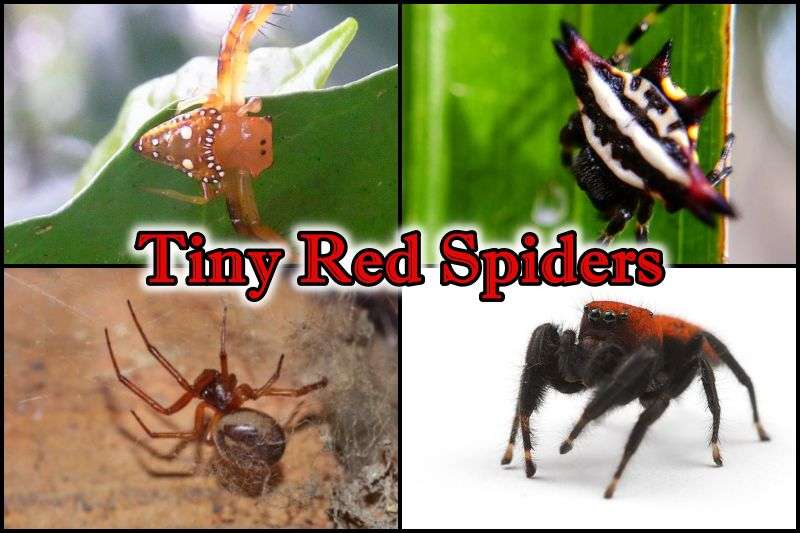Nature has its fair share of beautiful living beings, there in every shape and color. Spiders, no matter how terrifying they look, sometimes have enchanting red coloration on their small bodies. These little red spiders are relatively common and can be found anywhere around the globe. This time, we’re taking 15+ tiny red spiders worldwide that are unbelievably beautiful to make a list.
For this list, we’re excluding the Clover Mites, commonly referred to and mistaken for small red spiders. We’re taking other spiders from around the world that are tiny and red. Let’s see how the list goes:
15+ Tiny Red Spiders Worldwide
1) Black-Tailed Red Sheetweaver Spider
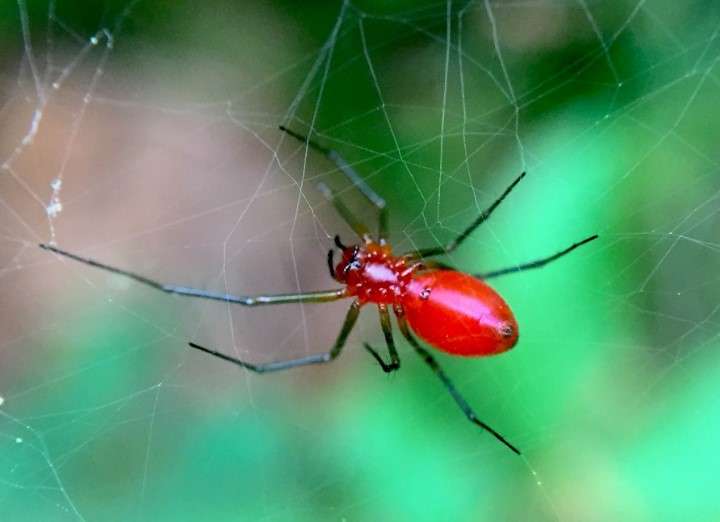
The very first spider on this list of tiny red spiders is the Black-tailed Red Sheetweaver. The little spiders usually inhabit grasslands, agricultural fields, and lawns. They are bright red in color, with reddish-brown to black legs and a black tubercle on the abdomen.
The black-tailed red sheet weaver gets its name from the particular way it weaves its web. The web is horizontal at the base, with additional webs woven above it. The function of the extra webs is to stop flying prey and cause it to fall on the horizontal sheet.
- Common Name: Red Grass Spider
- Scientific name: Florinda coccinea
- Size: 3 – 4 mm
- Location: Mexico, West Indies, United States
2) South American Black Widow
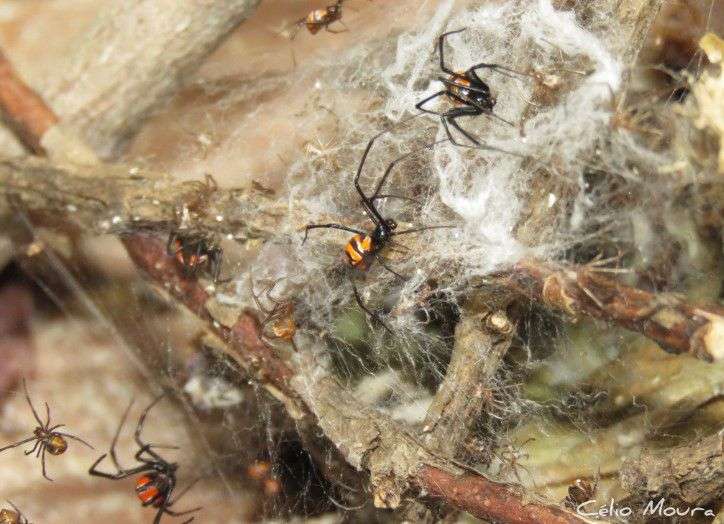
South American Black Widow is a species of the Latrodectus genus and, like every other of its species, venomous in nature. The venom of this black widow contains neurotoxins that cause intense pain in the bitten area.
The females of this species are more significant than the males. The males are brown or white, while the females are red and black. The back of the female has four red triangles and a black diamond shape.
- Common Name: Brazilian Black Widow
- Scientific name: Latrodectus curacaviensis
- Size: 11 – 17 mm
- Location: South America, Lesser Antilles
3) Whitman’s Jumping Spider
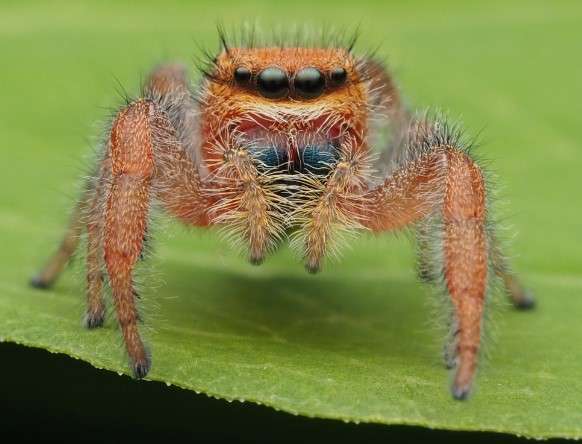
Whitman’s Jumping Spider is a species of little spider with a bright red body and spiny legs. These spiders usually take shelter in woodlands and open fields. Their superior eyesight is their main weapon for attacking prey rather than their webs.
Whitman’s jumping spiders are pretty aggressive in nature and can bite if stressed or under threat. Their bite doesn’t harm humans dangerously, only swelling and pain at the bitten spot.
- Scientific name: Phidippus whitmani
- Size: 10 mm
- Location: Canada, United States
4) Red Tent Spider
We’ll end the list of tiny red spiders with the Red Tent Spider. The spiders of this species are native to the countries of east and southeast Asia. They are larger in size than our other entries. The females are a lot bigger than the males.
The female red tent spider is, as its name implies, bright red in color. These spiders are also known for weaving three-dimensional webs.
- Scientific name: Cyrtophora unicolor
- Size: 17 – 20 mm
- Location: India, Singapore, China, Southern Taiwan, Japan, Philippines, Papua New Guinea, Indonesia, Christmas Island, Sri Lanka, Thailand, Myanmar
5) Black Banded Crab Spider
The Black Banded Crab Spider finds its unique name from its unique sitting position. The small back pairs of legs of these spiders are significantly far from their larger front pairs of legs. This makes the spiders sit in a way similar to a crab.
The spiders of this species are very small and have red cephalothorax. The abdomen of these spiders is more orange than red, with a black mark at the end. The black-banded crab spiders also have mild venom.
- Scientific name: Synema parvulum
- Size: 2 – 11 mm
- Location: Mexico, United States
6) Red House Spider
Red House Spider is a common spider species found all over the globe. These tiny spiders take shelter indoors, preferring dark and cool areas of the house. They are solitary and venomous, though their venom is not dangerous for humans.
Red house spiders are very small. Their cephalothorax and abdomen are red, while their legs are orange with tiny spines. These spiders are known for weaving messy and tangled webs.
- Scientific name: Nesticodes rufipes
- Size: 5 – 8 mm
- Location: Pantropical
7) Red Spiked Orb Weaver Spider
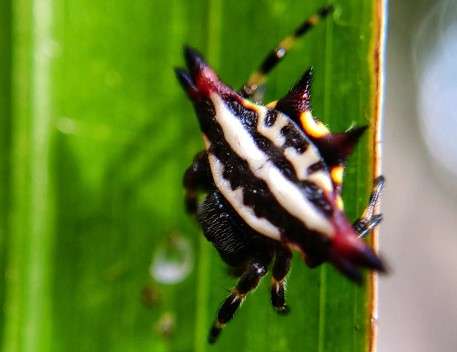
The Red Spiked Orb Weaver Spider is a species of tiny spider with bright red bodies. The spiders have a red-colored abdomen patterned with uneven burgundy stripes and maroon heads. These tiny spiders are recognized by their broad bodies with distinct, crab-like spines.
The preferred habitats of the red spiked orb weaver are woodlands and shrubberies. They weave intricate webs and sit at the center of them, waiting for their prey.
- Scientific name: Gasteracantha falcicornis
- Size: Length: 5 – 9 mm; width: 10 – 13 mm
- Location: Eastern and southern Africa
8) Woodlouse Spider
The Woodlouse Spiders have a particular diet of woodlice and pillbugs, causing several of its nicknames. They inhabit outdoor spaces like rocks, logs, bricks, and potted plants and usually avoid places with humans. These small spiders don’t weave webs and use their strong jaws and venom for hunting during the night.
The cephalothorax of the woodlouse spiders ranges from red to deep orange. The abdomen is grayish brown, and the legs are translucent and orange.
- Common Name: Woodlouse Hunter, Sowbug Hunter, Sowbug Killer, Pillbug Hunter, Slater Spider
- Scientific name: Dysdera crocata
- Size: female: 11 – 15 mm; male: 9 – 10 mm
- Location: Eurasia, North and South America, South Africa, Australia, New Zealand
9) Shamrock Orbweaver
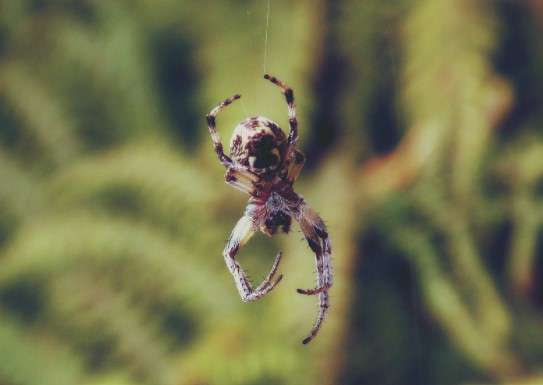
The Shamrock Orb Weaver is another orb weaver on our list. These tiny spiders come in many colors, most commonly brown or beige, but they can also be found in red, yellow, and orange. They have characteristic white dots on their abdomen and white bandlike patterns on the joints of their legs.
The Shamrock orb weavers spin large webs that can expand up to 2 ft in diameter. They prey on small flying insects. Though they are not excessively aggressive, they can bite humans under threat, but their bite is not dangerous and only causes pain, similar to a bee sting.
- Scientific name: Araneus trifolium
- Size: 4 – 20 mm
- Location: Canada, United States
10) Apache Jumping Spider
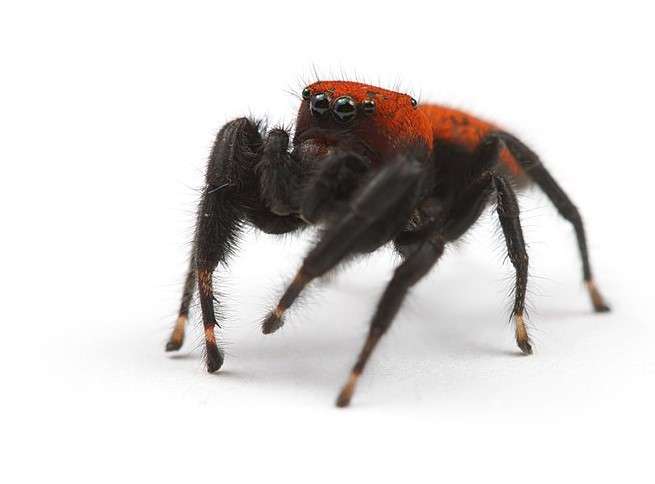
Like many spider species, the males and the females of the Apache Jumping Spider have huge differences in size. The males are almost seven times smaller than the females.
The sexes also have distinct differences in their coloration. The female spiders are more orange in the abdomen and cephalothorax, while the males are red in color.
The apache jumping spiders don’t make webs but rather create a silken structure similar to a tent to hunt prey. They are also venomous, but their venom is too mild to cause much harm to humans.
- Scientific name: Phidippus apacheanus
- Size: female: 22 mm; male: 3 mm
- Location: Cuba, Mexico, United States
11) Comstock’s Wafer Trapdoor Spider
Comparatively larger than others on this list, Comstock’s Wafer Trapdoor Spider is a member of the family of Water-lid Trapdoor Spiders. These spiders have bright red cephalothorax, abdomen, and legs. The abdomen and legs are covered with short black hairs. They also have a small black mark on the head.
These spiders are pretty open with their presence near humans and often live indoors. They climb the wall in light-filled places to wait for their prey to get caught.
- Scientific name: Myrmekiaphila comstocki
- Size: 10 – 40 mm
- Location: Mexico, United States
12) Emerton’s Bitubercled Cobweaver
Emerton’s Bitubercled Cobweaver is a species of tiny spider usually found in Canada and the USA. These spiders have slight differences in size in males and females, though both are very small. The abdomen of these spiders has a dome shape and is a muted red in color, with dark brown coloring the pointed edges.
These Cobweaver spiders choose their natural habitat in woodlands and gardens and like to sit on plant stems or leaves.
- Scientific name: Theridula emertoni
- Size: female: 1.7 – 2.8 mm; male: 1.6 – 2.3 mm
- Location: Canada, United States
13) Triangular Spider
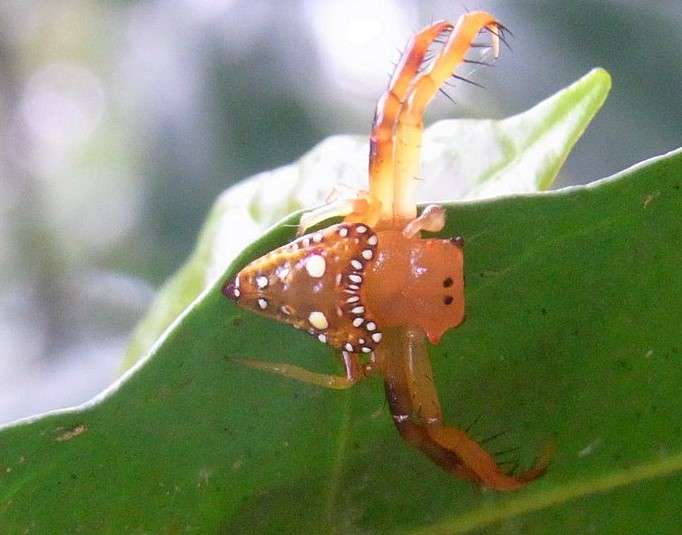
The Common Triangular Spider is named so because of its characteristic triangular abdomen. The color of the abdomen can range from orange to red to yellow and is patterned with white, circular spots. The head and legs are translucent-looking. These little spiders have smaller hind legs and spiny, curved front legs.
The common triangular spiders prefer to live in woodlands and eucalyptus forests, but they often also take shelter in shrub gardens. They feed on flies and other such small flying insects.
- Scientific name: Arkys lancearius
- Size: 5 – 8 mm
- Location: Australia
14) Broad Faced Sac Spider
Here’s another sac spider in our midst, and it’s the Broad-Faced Sac Spider. These tiny spiders have deep red cephalothorax with grayish beige abdomen with small pores. The legs of the spiders are hairless and vibrant in color.
These spiders can be pretty dangerous as the females are aggressive and tend to bite easily. The bite is not only very painful but needs medical attention. The males are more reserved in comparison.
- Scientific name: Trachelas tranquillus
- Size: female: 7 – 10 mm; male: 5 – 6 mm
- Location: Canada, United States
15) Red and White Asagena Spider
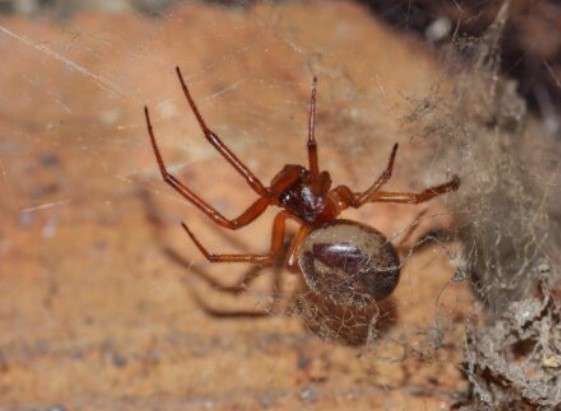
The final entry on the tiny spiders list is the Red and White Asagena Spider. These little spiders are almost entirely red. The cephalothorax and legs are bright red with little hair. The abdomen is a darker red with distinct white, uneven patterns at the middle of it and white markings near the edges.
These spiders prefer dry lands with small amounts of rain. They are found in dry regions of Mexico and the USA.
- Scientific name: Asagena fulva
- Size: 5 – 10 mm
- Location: Mexico, United States
Red spiders are pretty common in nature, and most of them are nontoxic and don’t pose any danger to humans. Though some have venoms, with the exception of the black widow, the venoms are mild in most cases. We’ll stop here today and conclude our list of 15+ tiny red spiders worldwide. Let us know your thoughts, and if you are an animal enthusiast, you can check out some of our other articles with cool topics.
References
Leafy Place, Pet Enthusiast, Earthling Nature, Insect Identification, Spider Identifications
Also Read:
Anamika has a fascination with all living things. Being a Zoology student, she loves to know new interesting things about animals. She’s also a very keen fan of manga and anime. Writing is her passion, and writing about her favorite things is her boost of serotonin.
